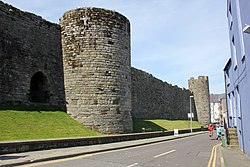
Back Caernarfon bymur Danish Enceinte de Caernarfon French Tembok kota Caernarfon ID Muralhas de Caernarfon Portuguese
| Caernarfon town walls | |
|---|---|
| Caernarfon, North Wales | |
 Caernarfon town walls along Greengate Street | |
| Coordinates | 53°08′17″N 4°15′59″W / 53.1381°N 4.2663°W |
| Grid reference | grid reference SH485625 |
| Type | Town wall |
| Site information | |
| Controlled by | Cadw |
| Open to the public | Yes |
| Condition | Intact |
| Part of | Castles and Town Walls of King Edward in Gwynedd |
| Criteria | Cultural: i, iii, iv |
| Reference | 374 |
| Inscription | 1986 (10th Session) |
| Official name | Caernarfon Town Wall[1] |
| Reference no. | CN034[1] |
Caernarfon's town walls are a medieval defensive structure around the town of Caernarfon in North Wales. The walls were constructed between 1283 and 1292 after the foundation of Caernarfon by Edward I, alongside the adjacent castle. The walls are 734 m (2,408 ft) long and include eight towers and two medieval gatehouses. The project was completed using large numbers of labourers brought in from England; the cost of building the walls came to around £3,500, a large sum for the period. The walls were significantly damaged during the rebellion of Madog ap Llywelyn in 1294, and had to be repaired at considerable expense. Political changes in the 16th century reduced the need to maintain such defences around the town. Today the walls form part of the UNESCO World Heritage Site administered by Cadw. Archaeologists Oliver Creighton and Robert Higham describe the defences as "a remarkably intact walled circuit".[2]
- ^ a b Cadw. "Caernarfon Town Wall (Grade SM) (CN034)". National Historic Assets of Wales. Retrieved 12 June 2022.
- ^ Creighton and Higham, p. 274.
